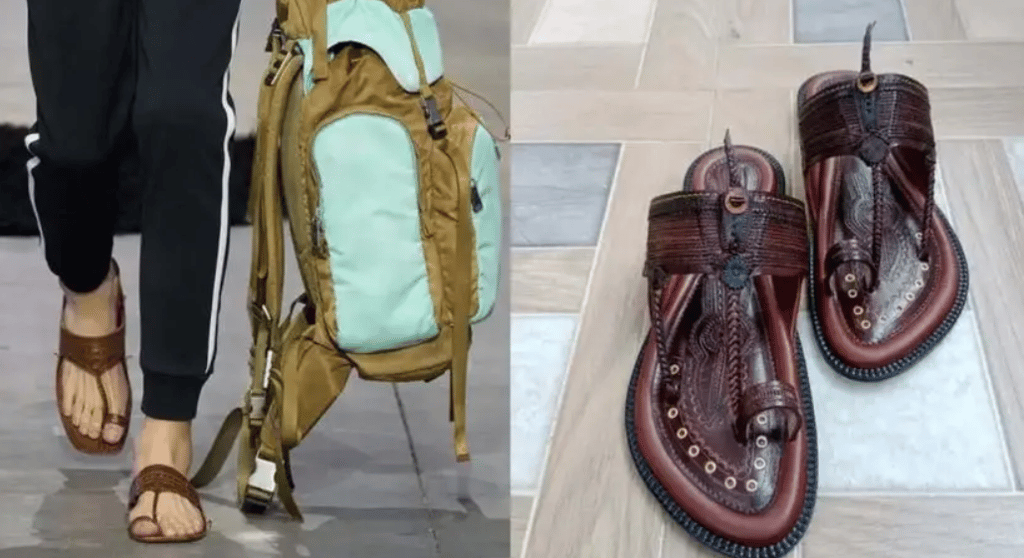The Prada Kolhapuri Controversy: When Luxury Walks All Over Legacy
Why the global fashion industry owes more than just ‘inspiration’ to Indian artisans—and what India must do about it.
7/11/20253 min read


Kolhapur, Maharashtra – a town synonymous with centuries-old leather craftsmanship – has suddenly found itself in the global fashion spotlight. And not for reasons that sit well with the artisans who’ve spent generations perfecting their skill.
At the heart of the storm? Italian luxury powerhouse Prada, which showcased a pair of sandals at the Milan Fashion Week Spring 2026, bearing a striking resemblance to the traditional Kolhapuri chappal. Handcrafted by artisans for over 800 years, these sandals carry more than just style—they carry cultural memory, community resilience, and craft lineage. But what the sandals on Prada’s runway didn’t carry was credit.
The Heartbeat of Kolhapur, Now a Hashtag
When news broke that Prada’s latest collection included “heritage-inspired” leather sandals, India’s artisans weren't applauding—they were outraged. The brand made no initial mention of Kolhapur, nor of the communities behind the design. On social media, the backlash was immediate, under hashtags like #PradaKolhapuriControversy and #CreditTheCraft.
“I earn $5 a day making Kolhapuri chappals,” says Sadashiv Sanake, a 58-year-old artisan interviewed by BBC news post controversy in Kolhapur. His workshop walls echo with the rhythmic hammering of leatherwork. When shown the Prada sandals, his response was blunt: “Do they have gold in them?”
Meanwhile, Prada sandals routinely retail between £600–£1000 on the luxury market.
A Case of Cultural Appropriation or Missed Opportunity?
Let’s be clear, this isn’t merely a design inspiration issue. It’s about cultural appropriation, economic disparity, and the lack of institutional protection for traditional Indian crafts. The Kolhapuri sandal, awarded a Geographical Indication (GI) tag in 2019 by the Indian government, is legally protected within India. But globally? It’s still fair game for replication—without credit, collaboration, or compensation.
Ritu Beri, one of India’s most prominent designers, put it plainly: “It’s about ethical recognition. India must push for royalty-sharing and co-branding.”
The craft was originally developed by the Charmakar community, one of the most marginalised groups in India. For generations, they have worked with leather despite social ostracisation and government neglect. To see their work massified and glamourised without recognition is more than oversight—it’s erasure.
From Footpath to Fashion Week: And Still, No Credit
In the wake of the controversy, local leaders and craft councils like the Maharashtra Chamber of Commerce, Industry & Agriculture (MACCIA) stepped in, demanding action. Prada eventually acknowledged the sandals’ Indian roots and is reportedly in discussions with MCCIA. A formal meeting is scheduled soon.
Legal petitions have also been filed, demanding damages, a court-supervised artisan collaboration, and royalty redistribution.
But beyond courtroom gestures, the artisans want respect! “The pattern Prada used wasn’t even popular,” says Rohit Balkrishna Gavali, a second-gen Kolhapuri seller, “but now, people are asking for it. Sometimes, controversy brings visibility. What we need is fairness.”-BBC
The Broader Pattern: When Indian Craft Becomes Disposable Luxury
This isn't the first time global fashion has flirted with Indian heritage without commitment. From Chikankari to Ikat, from Ajrakh block prints to mirror embroidery, Indian textiles have repeatedly appeared on runways under foreign labels, with no nod to their origins.
Designs are lifted. Stories are lost. Artisans are left behind.
Despite a $200 million+ domestic leather sandal industry and 100,000+ artisans working across India, the community remains vulnerable—underpaid, overworked, and overshadowed.
The 2015 Maharashtra ban on cow slaughter further squeezed their resources, forcing reliance on more expensive buffalo leather. Add to that the flood of synthetic knock-offs and machine-made duplicates, and the survival of authentic Kolhapuris is constantly under threat.
What to do next??
It’s Time India Walked the Talk
The Prada Kolhapuri controversy is not just about a luxury brand borrowing a silhouette. It's about a global imbalance in recognition and reward. It calls into question who gets to profit off culture, and who gets left behind in poverty.
It’s a moment for the Indian government to act beyond GI tags and into global advocacy. Raise the issue at WTO under the TRIPS agreement. Push for international design protection. Demand co-branding models. Fund artisan education and IP literacy.
Because until India protects its heritage with the same pride it wears it, the world will keep cashing in on our culture—while our artisans remain invisible.
As we say in fashion: what goes around, comes around.
Let’s ensure it comes back home with dignity, credit, and fair pay.
